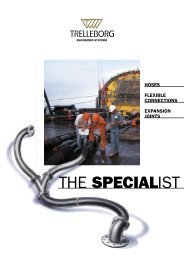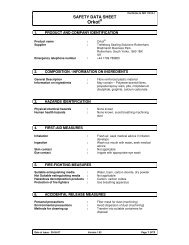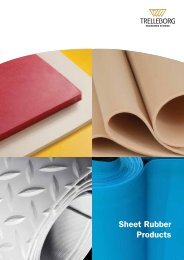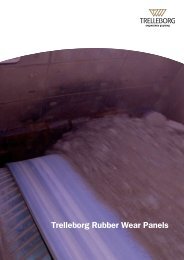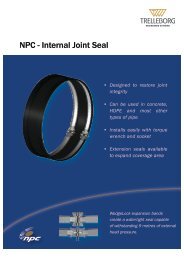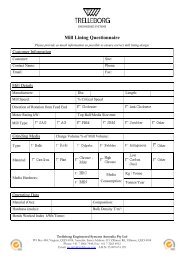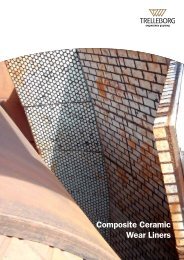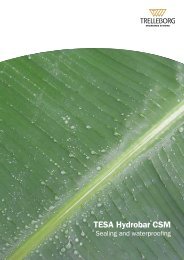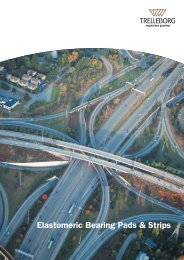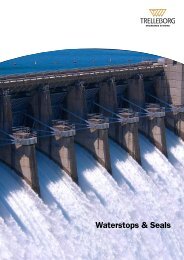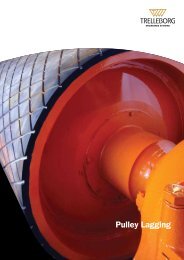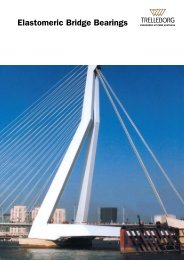<strong>Orkot</strong> ® <strong>Marine</strong> <strong>Bearings</strong><strong>Engineering</strong> <strong>Manual</strong> for Rudder and Water Lubricated Propeller Shaft <strong>Bearings</strong>Rudder <strong>Bearings</strong>This section provides general advice on rudder bearingdesign. It also provides the information required toallow the user to calculate the machining sizes of arudder bearing before and after fitting.Page 24 shows a <strong>com</strong>pleted example of the <strong>Orkot</strong> ®<strong>Marine</strong> <strong>Bearings</strong> calculation for you to examine.Page 23 contains a blank for you to <strong>com</strong>plete yourown calculation. Alternatively please feel free tocontact your local agent, distributor or manufacturingplant and we will be happy to advise you of themachining sizes.A spreadsheet based calculation program is availableupon request.Prior to carrying out any calculation, the followinginformation must be available:● Minimum bearing operating temperature● Approximate ambient temperature duringmachining● Housing and shaft sizes with tolerancesBearing Design Pressure<strong>Orkot</strong> ® TLM <strong>Marine</strong> has classification approval for up to15N/mm 2 (2,176 lb/in 2 ) in rudder bearing applications,while TXM <strong>Marine</strong> has approval for up to 10N/mm 2(1,450 lbs/in 2 ). Clearly, this is linked to the applicationand the other <strong>com</strong>ponents involved. When lookingonly at the properties of <strong>Orkot</strong> ® <strong>Marine</strong> bearings muchhigher loads can be sustained. <strong>Orkot</strong> ® <strong>Marine</strong> bearingsare in use in many other applications such as deckcranes, hatch cover slide pads, mooring systems andships stabilisers operating at bearing pressures rangingfrom 25 up to 100 N/mm 2 (3,626 - 14,504 lb/in 2 ).LubricationWater, grease or oil can provide bearing lubricationdepending on the application. No axial grooves arerequired with lubricated rudder bearings. <strong>Orkot</strong> ® TLM<strong>Marine</strong> rudder bearings are capable of intermittentdry running against K-Monel ® , Inconel ® 625, Stellite ® ,duplex stainless and suitable corrosion resistantstainless steels.Housing and Shaft RequirementsHousingThe bearing housings internal diameter, particularly onrefits, should be measured in at least three positionsalong its length. At least two measurements shouldthen be taken at 90 degrees to each other in the radialplane and the resultant figures used to obtain theaverage diameters of each position. If the housing isoval or tapered <strong>Orkot</strong> ® can still be used if the problem isnot excessive (0.1mm per 100 mm or 0.004” per 4”), thematerial has some elasticity, but it will not <strong>com</strong>pensatefor severe wear. It should be noted that the bearingwill take the shape of the housing when fitted with aninterference.The housing should be provided with an adequatechamfer to prevent shaving the bearing whenpress fitting.After fitting the bearing should be retained at oneend by a shoulder and for additional axial security akeeper ring may be used at the other. The followingdiagram illustrates this method.Material Selection<strong>Orkot</strong> ® TLM <strong>Marine</strong> is the preferred material grade forrudder stock, pintle, neck and carrier bearings. Itincorporates solid lubricants which enable dry runningto ensure outstanding wear life for all rudder bushesoperating above or below the draft line. The materialwill operate without lubrication at pressures of 30N/mm 2 (4,351 lb/in 2 ) for short periods and has beentested at pressures of 14.5 N/mm 2 (2,103 lb/in 2 ) with avelocity of 1.3 m/min (4.3 ft/min) for 1.5 million cycleswith minimum lubrication.<strong>Orkot</strong> ® TXM <strong>Marine</strong> is a high performance materialwhich exhibits lower friction and wear properties thanour TLM <strong>Marine</strong> grade. It is approved to operatewithout lubrication in rudder bearing applications andhas been tested, with lubrication against stainless steelfor submarine steering gear at 57 N/mm 2 (8,267 lb/in 2 )at 1 m/min (3.3 ft/min).Figure 1: Fitted bearingShaftThe shaft or liner surface in contact with an <strong>Orkot</strong> ®<strong>Marine</strong> bearing when lubricated by water must be ofcorrosion resistant material to ensure low wear.Suitable materials are seawater corrosion resistantstainless steel, phosphor bronze, gunmetal, Inconel ®625 and Stellite ® .The shaft should be smooth, without cutting edges.The ideal shaft surface finish is between 0.1 and 0.8 Ramicrometers or 4 and 32 Ra micro inches.7
<strong>Orkot</strong> ® <strong>Marine</strong> <strong>Bearings</strong><strong>Engineering</strong> <strong>Manual</strong> for Rudder and Water Lubricated Propeller Shaft <strong>Bearings</strong>DesignWall ThicknessNormally in refits, the wall thickness of the bearing isfixed by the shaft and housing dimensions.For new bearing designs the optimum wall thicknessshould be calculated as:0.04 x shaft diameter plus 2 mm (0.08”).Any bearing design with a wall thickness below thisvalue should always be checked by our engineeringdepartment to ensure it meets our minimumrequirements.It should be noted that when an <strong>Orkot</strong> ® <strong>Marine</strong>bearing of the optimum thickness is fitted into ahousing the interference is reflected as a reduction ofthe bearings internal diameter after fitting, i.e. thewall thickness before and after fitting will normallyremain constant. <strong>Bearings</strong> with thicker than optimumwalls may give less ”bore closure“.Bearing InterferenceAs with all polymer bearings, the interference requiredto hold the bearing in place during operation is higherthan that required by metal bearings bec<strong>au</strong>se themodulus of polymer materials is lower.Tables 4, 5, 6 and 7 show the various values for“m” and “c” that are required to calculate there<strong>com</strong>mended interference for <strong>Orkot</strong> ® <strong>Marine</strong> rudderbearings. These values are dependent upon theminimum operating temperature of the bearing andthe temperature of the machine shop at the time ofmachining. These temperature figures should be usedin relation with these tables when selecting the valuesof “m” and “c”.Once these values have been obtained from the tablesthey should be entered into the following equation inorder to calculate the required interference.Interference = (m x Housing ID) + cOnce an interference value has been calculated it canbe entered into the <strong>Marine</strong> Bearing Calculation.Table 4 Table 5OperatingValue of "m"TempMachining Temperature (°C)(°C) 0 5 10 15 20 25 300 0.00131 0.00155 0.00178 0.00202 0.00225 0.00249 0.00273-10 0.00178 0.00202 0.00225 0.00249 0.00273 0.00296 0.00320-20 0.00229 0.00253 0.00277 0.00300 0.00324 0.00347 0.00371-30 0.00291 0.00311 0.00331 0.00351 0.00371 0.00391 0.00411OperatingTemp Value(°C) of "c"0 -0.125-10 -0.125-20 -0.143-30 -0.158Table 6 Table 7OperatingValue of "m"TempMachining Temperature (°F)(°F) 32 41 50 59 68 77 860 0.00131 0.00155 0.00178 0.00202 0.00225 0.00249 0.00273-10 0.00178 0.00202 0.00225 0.00249 0.00273 0.00296 0.00320-20 0.00229 0.00253 0.00277 0.00300 0.00324 0.00347 0.00371-30 0.00291 0.00311 0.00331 0.00351 0.00371 0.00391 0.00411OperatingTemp Value(°F) of "c"32 -0.0049214 -0.00492-4 -0.00563-22 -0.006228




